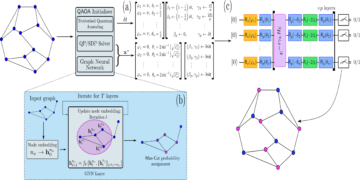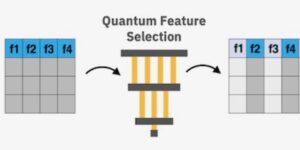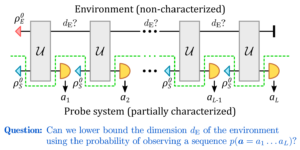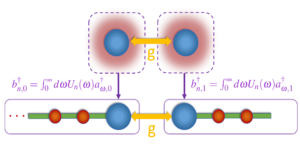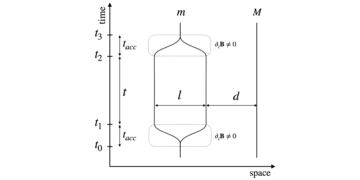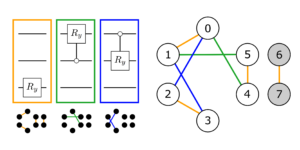1Joint Laboratory of Optics of Palacký University and Institute of Physics of CAS, Faculty of Science, Palacký University, 17. listopadu 12, 771 46 Olomouc, Czech Republic
2Institute of Spintronics and Quantum Information, Faculty of Physics, Adam Mickiewicz University, 61-614 Poznań, Poland
Find this paper interesting or want to discuss? Scite or leave a comment on SciRate.
Abstract
Equivalent approaches to determine eigenfrequencies of the Liouvillians of open quantum systems are discussed using the solution of the Heisenberg-Langevin equations and the corresponding equations for operator moments. A simple damped two-level atom is analyzed to demonstrate the equivalence of both approaches. The suggested method is used to reveal the structure as well as eigenfrequencies of the dynamics matrices of the corresponding equations of motion and their degeneracies for interacting bosonic modes described by general quadratic Hamiltonians. Quantum Liouvillian exceptional and diabolical points and their degeneracies are explicitly discussed for the case of two modes. Quantum hybrid diabolical exceptional points (inherited, genuine, and induced) and hidden exceptional points, which are not recognized directly in amplitude spectra, are observed. The presented approach via the Heisenberg-Langevin equations paves the general way to a detailed analysis of quantum exceptional and diabolical points in infinitely dimensional open quantum systems.
Featured image: Two doubled cones of quantum exceptional points intersect to give rise to quantum hybrid diabolical exceptional points.
Popular summary
► BibTeX data
► References
[1] C. M. Bender and S. Boettcher. “Real spectra in non-Hermitian Hamiltonians having $mathcal{PT}$ symmetry”. Phys. Rev. Lett. 80, 5243–5246 (1998).
https://doi.org/10.1103/PhysRevLett.80.5243
[2] C. M. Bender, D. C. Brody, and H. F. Jones. “Must a Hamiltonian be Hermitian?”. Am. J. Phys. 71, 1095–1102 (2003).
https://doi.org/10.1119/1.1574043
[3] C. M. Bender. “Making sense of non-Hermitian Hamiltonians”. Reports Progress Phys. 70, 947 (2007).
https://doi.org/10.1088/0034-4885/70/6/R03
[4] R. El-Ganainy, K. G. Makris, M. Khajavikhan, Z. H. Musslimani, S. Rotter, and D. N. Christodoulides. “Non-Hermitian physics and $mathcal{PT}$ symmetry”. Nat. Phys. 14, 11 (2018).
https://doi.org/10.1038/nphys4323
[5] Y. Ashida, Z. Gong, and M. Ueda. “Non-Hermitian physics”. Adv. Phys. 69, 249 (2020).
https://doi.org/10.1080/00018732.2021.1876991
[6] A. Mostafazadeh. “Pseudo-Hermiticity and generalized $mathcal{PT}$ and $mathcal{CPT}$-symmetries”. J. Math. Phys. (Melville, NY) 44, 974 (2003).
https://doi.org/10.1063/1.1539304
[7] A. Mostafazadeh. “Time dependent Hilbert spaces, geometric phases, and general covariance in quantum mechanics”. Phys. Lett. A 320, 375 (2004).
https://doi.org/10.1016/j.physleta.2003.12.008
[8] A. Mostafazadeh. “Pseudo-Hermitian representation of quantum mechanics”. Int. J. Geom. Methods Mod. Phys. 7, 1191 (2010).
https://doi.org/10.1142/S0219887810004816
[9] M. Znojil. “Time-dependent version of crypto-Hermitian quantum theory”. Phys. Rev. D 78, 085003 (2008).
https://doi.org/10.1103/PhysRevD.78.085003
[10] D. C. Brody. “Biorthogonal quantum mechanics”. J. Phys. A: Math. Theor. 47, 035305 (2014).
https://doi.org/10.1088/1751-8113/47/3/035305
[11] F. Bagarello, R. Passante, and C. Trapani. “Non-Hermitian Hamiltonians in quantum physics”. In Non-Hermitian Hamiltonians in Quantum Physics. Springer, New York (2016).
[12] L. Feng, R. El-Ganainy, and L. Ge. “Non-Hermitian photonics based on parity-time symmetry”. Nat. Photon. 11, 752 (2017).
https://doi.org/10.1038/s41566-017-0031-1
[13] R. El-Ganainy, M. Khajavikhan, D. N. Christodoulides, and Ş. K. Özdemir. “The dawn of non-Hermitian optics”. Commun. Phys. 2, 1 (2019).
https://doi.org/10.1038/s42005-019-0130-z
[14] M. Parto, Y. G. N. Liu, B. Bahari, M. Khajavikhan, and D. N. Christodoulides. “Non-Hermitian and topological photonics: optics at an exceptional point”. Nanophotonics 10, 403 (2021).
https://doi.org/10.1515/nanoph-2020-0434
[15] Ch.-Y. Ju, A. Miranowicz, F. Minganti, C.-Ts. Chan, G.-Y. Chen, and F. Nori. “Flattening the curve with Einstein’s quantum elevator: Hermitization of Non-Hermitian Hamiltonians via the vielbein formalism”. Phys. Rev. Research 4, 023070 (2022).
https://doi.org/10.1103/PhysRevResearch.4.023070
[16] M. Znojil. “Is $mathcal{PT}$-symmetric quantum theory false as a fundamental theory?”. Acta Polytech. 56, 254 (2016).
https://doi.org/10.14311/AP.2016.56.0254
[17] C.-Y. Ju, A. Miranowicz, G.-Y. Chen, and F. Nori. “Non-Hermitian Hamiltonians and no-go theorems in quantum information”. Phys. Rev. A 100, 062118 (2019).
https://doi.org/10.1103/PhysRevA.100.062118
[18] C. M. Bender, D. C. Brody, and M. P. Müller. “Hamiltonian for the zeros of the Riemann Zeta function”. Phys. Rev. Lett. 118, 130201 (2017).
https://doi.org/10.1103/PhysRevLett.118.130201
[19] Ş. K. Özdemir, S. Rotter, F. Nori, and L. Yang. “Parity–time symmetry and exceptional points in photonics”. Nat. Mater. 18, 783 (2019).
https://doi.org/10.1038/s41563-019-0304-9
[20] M.-A. Miri and A. Alù. “Exceptional points in optics and photonics”. Science 363, eaar7709 (2019).
https://doi.org/10.1126/science.aar7709
[21] F. Minganti, A. Miranowicz, R. Chhajlany, and F. Nori. “Quantum exceptional points of non-Hermitian Hamiltonians and Liouvillians: The effects of quantum jumps”. Phys. Rev. A 100, 062131 (2019).
https://doi.org/10.1103/PhysRevA.100.062131
[22] H. J. Carmichael. “Quantum trajectory theory for cascaded open systems”. Phys. Rev. Lett. 70, 2273 (1993).
https://doi.org/10.1103/PhysRevLett.70.2273
[23] J. Dalibard, Y. Castin, and K. Mølmer. “Wave-function approach to dissipative processes in quantum optics”. Phys. Rev. Lett. 68, 580 (1992).
https://doi.org/10.1103/PhysRevLett.68.580
[24] K. Mølmer, Y. Castin, and J. Dalibard. “Monte Carlo wavefunction method in quantum optics”. J. Opt. Soc. Am. B 10, 524 (1993).
https://doi.org/10.1364/JOSAB.10.000524
[25] M. B. Plenio and P. L. Knight. “The quantum-jump approach to dissipative dynamics in quantum optics”. Rev. Mod. Phys. 70, 101 (1998).
https://doi.org/10.1103/RevModPhys.70.101
[26] H. Breuer and F. Petruccione. “The theory of open quantum systems”. Oxford University Press, Oxford. (2007).
[27] J. Gunderson, J. Muldoon, K. W. Murch, and Y. N. Joglekar. “Floquet exceptional contours in Lindblad dynamics with time-periodic drive and dissipation”. Phys. Rev. A 103, 023718 (2021).
https://doi.org/10.1103/PhysRevA.103.023718
[28] W. Chen, M. Abbasi, B. Ha, S. Erdamar, Y. N. Joglekar, and K. W. Murch. “Decoherence induced exceptional points in a dissipative superconducting qubit”. Phys. Rev. Lett. 128, 110402 (2022).
https://doi.org/10.1103/PhysRevLett.128.110402
[29] M. Naghiloo, M. Abbasi, Y. N. Joglekar, and K. W. Murch. “Quantum state tomography across the exceptional point in a single dissipative qubit”. Nat. Phys. 15, 1232 (2019).
https://doi.org/10.1038/s41567-019-0652-z
[30] F. Minganti, A. Miranowicz, R. W. Chhajlany, I. I. Arkhipov, and F. Nori. “Hybrid-Liouvillian formalism connecting exceptional points of non-Hermitian Hamiltonians and Liouvillians via postselection of quantum trajectories”. Phys. Rev. A 101, 062112 (2020).
https://doi.org/10.1103/PhysRevA.101.062112
[31] F. Minganti, I. I. Arkhipov, A. Miranowicz, and F. Nori. “Liouvillian spectral collapse in the Scully-Lamb laser model”. Phys. Rev. Research 3, 043197 (2021).
https://doi.org/10.1103/PhysRevResearch.3.043197
[32] F. Minganti, I. I. Arkhipov, A. Miranowicz, and F. Nori. “Continuous dissipative phase transitions with or without symmetry breaking”. New J. Phys. 23, 122001 (2021).
https://doi.org/10.1088/1367-2630/ac3db8
[33] A. Lukš, V. Peřinová, and J. Peřina. “Principal squeezing of vacuum fluctuations”. Opt. Commun. 67, 149—151 (1988).
https://doi.org/10.1016/0030-4018(88)90322-7
[34] L. Mandel and E. Wolf. “Optical coherence and quantum optics”. Cambridge Univ. Press, Cambridge. (1995).
[35] J. Peřina. “Quantum statistics of linear and nonlinear optical phenomena”. Kluwer, Dordrecht. (1991).
[36] I. I. Arkhipov, F. Minganti, A. Miranowicz, and F. Nori. “Generating high-order quantum exceptional points in synthetic dimensions”. Phys. Rev. A 101, 012205 (2021).
https://doi.org/10.1103/PhysRevA.104.012205
[37] I. I. Arkhipov and F. Minganti. “Emergent non-Hermitian skin effect in the synthetic space of (anti-)$mathcal{PT}$-symmetric dimers” (2021).
[38] I. I. Arkhipov, A. Miranowicz, F. Nori, S. K. Özdemir, and F. Minganti. “Geometry of the field-moment spaces for quadratic bosonic systems: Diabolically degenerated exceptional points on complex $k$-polytopes” (2022).
[39] H. Mori. “Transport, collective motion, and Brownian motion”. Progr. Theor. Phys. 33, 423—445 (1965).
https://doi.org/10.1143/PTP.33.423
[40] M. Tokuyama and H. Mori. “Statistical-mechanical theory of random frequency modulations and generalized Brownian motions”. Progr. Theor. Phys. 55, 411—429 (1976).
https://doi.org/10.1143/PTP.55.411
[41] J. Peřina Jr. “On the equivalence of some projection operator techniques”. Physica A 214, 309—318 (1995).
https://doi.org/10.1016/0378-4371(94)00267-W
[42] W. Vogel and D. G. Welsch. “Quantum optics, 3rd ed.”. Wiley-VCH, Weinheim. (2006).
[43] P. Meystre and M. Sargent III. “Elements of quantum optics, 4nd edition”. Springer, Berlin. (2007).
[44] J. Peřina. “Coherence of light”. Kluwer, Dordrecht. (1985).
[45] I. I. Arkhipov, A. Miranowicz, F. Minganti, and F. Nori. “Quantum and semiclassical exceptional points of a linear system of coupled cavities with losses and gain within the Scully-Lamb laser theory”. Phys. Rev. A 101, 013812 (2020).
https://doi.org/10.1103/PhysRevA.101.013812
[46] J. Peřina Jr., A. Lukš, J. K. Kalaga, W. Leoński, and A. Miranowicz. “Nonclassical light at exceptional points of a quantum $mathcal{PT}$-symmetric two-mode system”. Phys. Rev. A 100, 053820 (2019).
https://doi.org/10.1103/PhysRevA.100.053820
[47] Z. Hu. “Eigenvalues and eigenvectors of a class of irreducible tridiagonal matrices”. Linear Algebra Its Appl. 619, 328—337 (2015).
https://doi.org/10.1016/j.laa.2021.03.014
[48] A. I. Lvovsky and M. G. Raymer. “Continuous-variable optical quantum state tomography”. Rev. Mod. Phys. 81, 299—332 (2009).
https://doi.org/10.1103/RevModPhys.81.299
[49] M. Bondani, A. Allevi, G. Zambra, M. G. A. Paris, and A. Andreoni. “Sub-shot-noise photon-number correlation in a mesoscopic twin beam of light”. Phys. Rev. A 76, 013833 (2007).
https://doi.org/10.1103/PhysRevA.76.013833
[50] J. Peřina Jr., P. Pavlíček, V. Michálek, R. Machulka, and O. Haderka. “Nonclassicality criteria for N-dimensional optical fields detected by quadratic detectors”. Phys. Rev. A 105, 013706 (2022).
https://doi.org/10.1103/PhysRevA.105.013706
[51] J. Peřina Jr. and A. Lukš. “Quantum behavior of a $mathcal{PT}$-symmetric two-mode system with cross-Kerr nonlinearity”. Symmetry 11, 1020 (2019).
https://doi.org/10.3390/sym11081020
[52] J. Peřina Jr. “Coherent light in intense spatiospectral twin beams”. Phys. Rev. A 93, 063857 (2016).
https://doi.org/10.1103/PhysRevA.93.063857
[53] J. Peřina Jr. and J. Peřina. “Quantum statistics of nonlinear optical couplers”. In E. Wolf, editor, Progress in Optics, Vol. 41. Pages 361—419. Elsevier, Amsterdam (2000).
https://doi.org/10.1016/S0079-6638(00)80020-7
[54] R. J. Glauber. “Coherent and incoherent states of the radiation field”. Phys. Rev. 131, 2766—2788 (1963).
https://doi.org/10.1103/PhysRev.131.2766
[55] E. C. G. Sudarshan. “Equivalence of semiclassical and quantum mechanical descriptions of statistical light beams”. Phys. Rev. Lett. 10, 277—179 (1963).
https://doi.org/10.1103/PhysRevLett.10.277
[56] H. Risken. “The Fokker-Planck equation”. Springer, Berlin. (1996).
Cited by
This Paper is published in Quantum under the Creative Commons Attribution 4.0 International (CC BY 4.0) license. Copyright remains with the original copyright holders such as the authors or their institutions.



